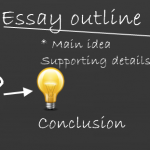 Outlining is a crucial step in the writing process, and, therefore, must not be neglected or taken lightly. Writing without a proper outline is the equivalent to building a house without a plan. Yes, you will end up with a structure that looks like a house, but soon upon entering the house, it will become quite obvious that something has gone off course. The same applies to writing an essay or research paper without a pre-established strategy that guides and controls the entire process. The final result may have all the elements you have intended to incorporate in your paper, but your ideas, logic and overall cohesion are likely to get lost. This results in a confusing piece of writing that is difficult to follow and comprehend.
Outlining is a crucial step in the writing process, and, therefore, must not be neglected or taken lightly. Writing without a proper outline is the equivalent to building a house without a plan. Yes, you will end up with a structure that looks like a house, but soon upon entering the house, it will become quite obvious that something has gone off course. The same applies to writing an essay or research paper without a pre-established strategy that guides and controls the entire process. The final result may have all the elements you have intended to incorporate in your paper, but your ideas, logic and overall cohesion are likely to get lost. This results in a confusing piece of writing that is difficult to follow and comprehend.
How to draft an outline
Let us revisit the analogy of the house here. The basic elements for a house-like structure to stand strong and hold its own weight are:
1- A foundation
2- Supporting columns
3- Walls and roof
In a way, an academic paper has a very similar structure to that of a house. A strong essay must have:
1- A foundation: Thesis
2- Supporting columns: Main ideas
3- Walls and roof: Supporting details
The Thesis
A well-developed paper must have a strong foundation (thesis). Begin the outlining process by establishing a clear and precise thesis statement that will serve as the base or under-structure of your paper. Write down your thesis statement.
Ex: Thesis Statement: Franz Kafka’s “Metamorphosis” suggests that stress, family dynamics and social isolation are factors that contributed to Gregor’s dehumanization even before his transformation into an insect.
Main ideas
Now that we have a clear and specific thesis, the next step is to identify how we are going to support it. For a typical 500-800 word academic essay, we need at least 3 supporting paragraphs. Each of these paragraphs will consist of ONE main idea that directly supports our pre-established thesis. The main idea is often referred to as the topic sentence and is generally the first sentence in the paragraph.
Ex: Main idea 1: Gregor’s family obligations pressure him to push aside his personal needs as a young man and work under a stressful conditions.
Supporting Details
Each main idea must be developed further using valid arguments and examples in order to clarify your points to the reader.
Supporting details include examples, anecdotes, explanations, facts, statistics, quotes, figures, testimonials.
![]() Click here to download our easy to use essay outline template
Click here to download our easy to use essay outline template
